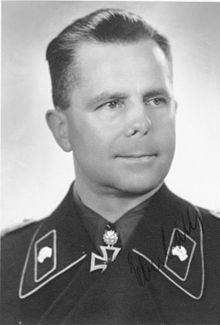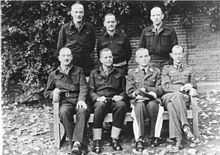Heinrich Eberbach
Heinrich Kurt Alfons Willy Eberbach (born November 24, 1895 in Stuttgart ; † July 13, 1992 in Notzingen ) was a German officer , most recently a general of the armored forces in World War II .
Life
First World War
Eberbach joined the 3rd Company of the 10th Württemberg Infantry Regiment No. 180 on July 1, 1914 as a flag junior . On May 15, 1915, he was transferred to the 8th Company of the Fusilier Regiment "Emperor Franz Josef of Austria, King of Hungary" (4th Württembergisches) No. 122 and promoted ten days later to lieutenant . After he was badly wounded in the face and "lost" his nose in the Battle of the Somme on September 25, 1916 , he was taken prisoner by the French. He recovered in a Swiss hospital and returned on September 4, 1917. His nose was then reconstructed by January 11, 1918. He was then assigned to the Replacement Battalion of the 122nd Infantry Regiment. On September 23, 1918 , his regiment surrendered to the British .
1920 to 1939
On January 1, 1920, Eberbach joined the police . He was used in Esslingen am Neckar and in Stuttgart. On December 13, 1919 he was promoted to lieutenant police, later to police captain and on August 1, 1933 to police major. The peak of his career in the police force was the head of the Reich Police Office .
On July 1, 1935, Eberbach joined the Reichswehr as a major . On October 14, 1935, he was appointed commander of anti-tank battalion 12. On August 1, 1936, he was transferred to the 6th Panzer Regiment of the 3rd Panzer Division . His promotion to lieutenant colonel took place on October 1, 1937. On November 10, 1938, Eberbach was appointed commander of the 35th Panzer Regiment in the 4th Panzer Division , which at that time was commanded by Lieutenant General Georg-Hans Reinhardt .
Second World War
In 1939 Eberbach took part in the raid on Poland with his 35th Panzer Regiment . On June 13, 1940 he was awarded the Knight's Cross of the Iron Cross . His regiment took part in the war against the Soviet Union from June 22, 1941 , where it was assigned to Army Group Center . On the Eastern Front , Eberbach was appointed commander of Panzer Brigade 5 of the 4th Panzer Division on July 2, 1941. During the battles for Smolensk , Kiev and Tula , General von Langermann was still his division commander, then from December 1941 he was subordinate to von Saucken . On March 1, 1942, Eberbach was promoted to major general and on January 1, 1943 to lieutenant general. In the spring of 1942 he took command of the entire 4th Panzer Division and in the winter of that year he became the commander of the LXXXIV. Armored Corps appointed. He was wounded five days later. On February 10, 1943, he was appointed commander of the armored forces of the reserve army . On February 18, 1943, he became an inspector of the Panzer Reserve Army. Finally, on August 1, 1943, he was promoted to General of the Panzer Force.
In June 1944 Eberbach was transferred to Army Group B in France . Units under his command fought on the Normandy landings against British troops who had landed at Juno and Sword Beach . In July he replaced Leo Geyr von Schweppenburg as commander in chief of Panzer Group West , which was later renamed the 5th Panzer Army . In August he took over command of the ad hoc Eberbach Panzer Group, which was part of the 7th Army and carried out the failed Liège operation. Most recently, Eberbach was commissioned to lead the 7th Army on August 22, 1944.
Captivity
On August 31, 1944, during a reconnaissance mission at Amiens near the Seine , Eberbach was captured by British troops.
Eberbach was a British prisoner of war in Trent Park until January 6, 1948 .
Operational History (German) Section
He later worked for the Operational History (German) Section of the United States Army Center of Military History of the United States Army .
family
Eberbach was married and his son Heinz Eugen Eberbach (1921–1982) also embarked on an officer career. He served as a submarine commander in World War II and later rose to become a sea captain in the German Navy .
Awards
- Iron Cross (1914) 2nd and 1st class
- Knight's Cross of the Friedrich Order II. Class with swords
- Wound badge (1918) in black
- Wehrmacht service award IV. To I. class
- Clasp for the Iron Cross, 2nd and 1st class
- Wound badge (1939) in silver
- Medal Winter Battle in the East 1941/42
- Tank battle badge in silver
-
Knight's Cross of the Iron Cross with oak leaves
- Knight's Cross on July 4th 1940
- Oak leaves on December 31, 1941 (42nd award)
- Mentioned in the Army Honorary Journal on December 8, 1941
literature
- G. Florenton: Battle of the Falaise Gap. Hawthorn Books, 1967.
- James Lucas: Battle Group! German Kampfgruppen Action of WWII. Arms & Armor Press, 1993.
- D. Eshel: Bravery in Battle. Pp. 47-48.
- James Lucas: Hitler's Commanders. 2000.
- Roger Edwards: Panzer: A Revolution In Warfare.
- Sönke Neitzel : bugged. German generals in British captivity 1942–1945 , Berlin / Munich: Propylaeen 2005, 638 p., 31 ill., ISBN 3-549-07261-9 .
- Wolfgang Keilig : The Generals of the Army 1939–1945 . Podzun-Pallas-Verlag, Friedberg 1983, ISBN 3-7909-0202-0 .
Web links
Individual evidence
- ↑ Wolfgang Keilig: The Generals of the Army 1939-1945 . Podzun-Pallas-Verlag, Friedberg 1983, p. 76
- ↑ (page 678 below): Chapter XXXII. Towards the Heart of Germany - The Mons Pocket
- ^ Sönke Neitzel: bugged. German generals in British captivity 1942–1945 , Berlin / Munich: Propylaea 2005
- ↑ Polly Kienle (2005): Still Fighting for the Myth: German Wehrmacht Officers' Reports for the US Historical Division in the Context of the Historiography on the Allied Normandy Breakout
- ↑ Dieter Hartwig: Grand Admiral Karl Dönitz - Legend and Reality , Ferdinand Schöningh, Paderborn 2010, ISBN 978-3-506-77027-1 , p. 314.
- ↑ Veit Scherzer : Knight's Cross bearers 1939-1945. The holders of the Iron Cross of the Army, Air Force, Navy, Waffen-SS, Volkssturm and armed forces allied with Germany according to the documents of the Federal Archives. 2nd Edition. Scherzers Militaer-Verlag, Ranis / Jena 2007, ISBN 978-3-938845-17-2 , p. 285.
| personal data | |
|---|---|
| SURNAME | Eberbach, Heinrich |
| ALTERNATIVE NAMES | Eberbach, Heinrich Kurt Alfons Willy |
| BRIEF DESCRIPTION | German officer, most recently General of the Armored Force in World War II |
| DATE OF BIRTH | November 24, 1895 |
| PLACE OF BIRTH | Stuttgart |
| DATE OF DEATH | July 13, 1992 |
| Place of death | Notzingen |

